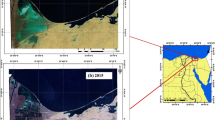Abstract
As an important part of Qinghai Plateau, the Qinghai Lake is a sensitive and fragile zone for global change impacts. It is one of the most strongly desertified regions on the Qinghai Plateau. Based on remote sensing, a geographic information system and using Thematic Mapper imagery for the years 1987, 2000, 2009 and Landsat 8 images for the year 2014 as data sources, we extracted information regarding the dynamic changes of aeolian desertification in the study area over the last 28 years. The spatio-temporal evolutions of the landscape patterns of regional aeolian desertified land (ADL) are discussed. Our objective is to provide references for desertification control and eco-environmental restoration in the Qinghai Lake basin (QLB). Results elicit an aeolian desertified area which has increased by 96.74 km2 over the past 28 years. ADL mainly experienced processes of increasing stable to decreasing trends, before 2000, the area of aeolian desertification increased by 338.03 km2. After 2000, desertification remains stable, but as we speak desertification decreases and a moderate and slight ADL took the lead. The dynamics of aeolian desertification in QLB is mainly determined by climate change, human activities and management.









Similar content being viewed by others
References
Alatorre LC, Beguería S (2009) Identification of eroded areas using remote sensing in a badlands landscape on marls in the central Spanish Pyrenees. Catena 76:182–190
Ding Y, Liu F (1995) Effect of climatic change of water balance of Qinghai lake basin for recent thirty years and possible tendency. Scientia Geographica Sinica 2:128–135 (In Chinese)
Duan HC, Wang T, Xue X et al (2014) Dynamics of aeolian desertification and its driving forces in the Horqin Sandy Land, Northern China. Environ Monit Assess 186:6083–6096
Gao J, Liu YS (2010) Determination of land degradation causes in Tongyu County, Northeast China via land cover change detection. Int J Appl Earth Obs Geoinf 12:9–16
Guo L, Sha Z, Ma Y et al (2010) The past 20 years of land desertification landscape pattern analysis of spatial variation of Qinghai Lake area. China Popul Resour Environ S1:119–123 (In Chinese)
Hu M, Tian L, Zhang D, LI S, Gao S (2012) Study on dynamic changes of aeolian desertification lands around Qinghai Lake in recent 30 years based on remote sensing and GIS. J Desert Res 4:002 (In Chinese)
Hu G, Dong Z, Lu J, Yan C (2015) The developmental trend and influencing factors of aeolian desertification in the Zoige Basin, eastern Qinghai–Tibet Plateau. Aeolian Res. doi:10.1016/j.aeolia.2015.02.002
Jing Y, Zhou S, Wu F, Zhang Q (2011) Study on optimal bands selection of Sandy Land information extraction in Sandy Land monitoring based on land sat remote sensing data. Chin Agric Sci Bull 17:029 (In Chinese)
Le Houérou HN (1996) Climate change, drought and desertification. J Arid Environ 34:133–185
Liberti M, Simoniello T, Carone MT et al (2009) Mapping badland areas using LANDSAT TM/ETM satellite imagery and morphological data. Geomorphology 106:333–343
Liu JY, Liu ML, Zhuang DF et al (2003) Study on spatial pattern of land-use change in China during 1995–2000. Sci China (D) 46:373–384
Roberto JF (2002) Do humans create deserts? Trends Ecol Evol 17:6–7
Roy DP, Wulder MA, Loveland TR et al (2014) Landsat-8: science and product vision for terrestrial global change research. Remote Sens Environ 145:154–172
Shen W, Li H, Sun M, Jiang J (2012) Dynamics of aeolian sandy land in the Yarlung Zangbo River basin of Tibet, China from 1975–2008. Glob Planet Change 86:37–44
Shi YF, Shen YP, Li DL et al (2003) Discussion on the present climate change from warm-day to warm-wet in Northwest China. Quat Sci 23:152–164 (In Chinese)
Wang L, Ha S (2004) Advance in desertification research of Horqin Sandy Land. J Nat Disasters 13:8–14 (In Chinese)
Wang XM, Dong ZB, Yan P et al (2005) Wind energy environments and dune field activity in the Chinese deserts. Geomorphology 65:33–48
Wang T, Yan CZ, Song X, Xie J (2012) Monitoring recent trends in the area of aeolian desertified land using Landsat images in China’s Xinjiang region. ISPRS J Photogramm Remote Sens 68:184–190
Wang T, Yan CZ, Song X et al (2013) Landsat images reveal trends in the aeolian desertification in a source area for sand and dust storms in China’s Alashan Plateau (1975–2007). Land Degrad Dev 24:422–429
Yan CZ, Song X, Zhou YM et al (2009) Assessment of aeolian desertification trends from 1975’s to 2005’s in the watershed of the Longyangxia Reservoir in the upper reaches of China’s Yellow River. Geomorphology 112:205–211
You Q, Kang S, Pepin N et al (2010) Climate warming and associated changes in atmospheric circulation in the eastern and central Tibetan Plateau from a homogenized dataset. Glob Planet Change 72:11–24
Yu W, Chen K (2002) Dynamic study on the remote sensing of desertified areas around the Qinghai Lake. J Salt Lake Res 10:48–51 (In Chinese)
Zhan X, Yan P (2012) Assessment and analysis of ecological benefit of combating desertification around Qinghai Lake. J Desert Res 32:1773–1778 (In Chinese)
Zhang H, Sha Z, Zhang T et al (2011) Spatial variation and driving force of sandy desertification in the peripheral area of the lake Qinghai in recent 20 years. J Arid Land Resour Environ 3:011 (In Chinese)
Zhao C, Lu R, Li J (2015) Land desertification and grain size characteristics of land surface deposits in the Qinghai lake watershed. J Desert Res 35:276–283 (In Chinese)
Acknowledgments
We gratefully acknowledge the funding received from the Opening Funding of Key Laboratory of Desert and Desertification, Chinese Academy of Sciences (KLDD-2014-007), the National Natural Science Foundation of China (41401412, 91125004, 41201372, 41301362) and the Foundation for Excellent Youth Scholars of CAREERI, CAS (51Y451271).
Author information
Authors and Affiliations
Corresponding author
Rights and permissions
About this article
Cite this article
Wang, H., Ma, M. & Geng, L. Monitoring the recent trend of aeolian desertification using Landsat TM and Landsat 8 imagery on the north-east Qinghai–Tibet Plateau in the Qinghai Lake basin. Nat Hazards 79, 1753–1772 (2015). https://doi.org/10.1007/s11069-015-1924-2
Received:
Accepted:
Published:
Issue Date:
DOI: https://doi.org/10.1007/s11069-015-1924-2




